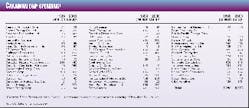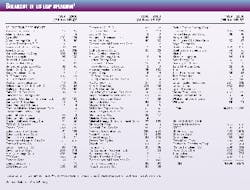The outlook for worldwide exploration and production expenditures is moderately bullish for 2000, according to Salomon Smith Barney, New York. This expected increase in E&P outlays marks the beginning of a long-anticipated recovery phase, the analyst said.
According to its 18th annual E&P spending survey, released earlier this year, Salomon forecasts worldwide upstream spending will increase in 2000 by 11.4%-or by nearly $10 billion-vs. estimates given in 1999.
In this year's survey, 177 oil and gas companies indicated plans to spend a total of $92.6 billion on their oil and gas field activities, up from $83.1 billion planned a year ago. About 67% of the planned spending for 2000 will be directed outside North America, 23% will be spent in the US-split 13% for independent firms and 10% for a reduced listing of major companies-and about 10% will be spent in Canada.
This increased figure is in sharp contrast with 1999 spending expectations, which showed a decline of about 18.2% vs. estimates for 1998, Salomon said. "The 1999 decline was not as severe as had been forecast in our midyear survey but still represents the second-worst contraction of E&P investment in the past 40 years.
"A year ago, we noted, 'the most tentative and uncertain sentiment in the industry for at least a decade' from conversations with survey respondents," the analyst said. "Much has changed since that time, particularly the oil price. However, memories of last year remain a factor among E&P industry participants, and these are reflected in the data we have collected from the...participants."
Since the release of its survey, Salomon has assembled a first quarter update to its analysis of E&P spending, which "reaffirms a strong E&P spending recovery in 2000," said Salomon analyst Mark Urness. "We believe these results reinforce our recent bullish posture on the oil service industry," he said.
Spending drivers
Two of the strongest influences on companies' spending decisions, Salomon noted, were oil price assumptions and uncertainty over what effect actions by the Organization of Petroleum Exporting Countries will have on the price of oil. These related factors have served to fuel some level of caution industry-wide.
"Among the major factors behind the caution is the concern that actions by OPEC countries may have artificially caused the sharp rise in oil prices since March [1999]," the analyst said. "The average of oil price assumptions for planning purposes has increased dramatically from last year and even from 6 months ago and is reminiscent of the 1996-97 period.
"At the same time, these assumptions represent a significantly lower price than the current futures strip," Salomon continued. The analyst went on to say that companies' spending patterns early in the year were most influenced by their expectations of how and when OPEC would change its production levels.
Another force strongly affecting spending decisions was the impact that various consolidations have had on industry, either direct or indirect, said Salomon. "For principals involved in these transactions," the analyst said, "we expect the level of investment will be curtailed by aggressive programs to achieve capital synergies from their mergers and that the pace of investment will be slowed by the process of integration and project high-grading.
"In addition, for companies that are not directly involved with these mergers, there is an expectation that divestitures arising from several of the megamergers will create new investment opportunities that may be superior to ones currently in the portfolio."
Also, the increase in merger and acquisition activity has "reduced the number of respondents with meaningful investment programs," Salomon said.
2000 spending breakout
Higher cash flows were the main impetus for increased spending plans of the 112 US independent companies surveyed, said Salomon. These firms plan to increase their outlays in 2000 to $12 billion, or by 15.3%, from 1999.
"Spending by [US independents] is now expected to be down 32.6% in 1999 vs. 1998, more severe than the 22.8% reduction that was originally forecast at this time last year, but less dramatic than the 35.9% contraction estimated in our midyear survey," the analyst said.
Higher oil and gas prices-and the cash flow associated with them-were respondents' chief reason for increasing spending plans. Salomon noted certain independents that planned "significant increases," namely, Noble Affiliates Inc., Consolidated Natural Gas Co., Apache Corp., Union Pacific Resources, Vastar Resources Inc., and Anadarko Petroleum Corp. (Table 3).
This year's survey listed 11 major oil firms as respondents. These companies plan to increase their US E&P outlays by 6.5% to $9.6 billion in 2000, Salomon said. Leading the group of majors with the steepest increase in spending was BP Amoco PLC, while Chevron Corp. and Occidental Petroleum Corp. followed closely behind.
"We have adjusted the BP Amoco forecast to reflect our expectation for the merger with ARCO...," the analyst said. "US spending by BP Amoco was larger in 1999 than is planned for 2000, but last year included a significant property acquisition that we have excluded from the 1999 numbers.
"Significant decreases in US spending are planned by ARCO (after adjustment) and Texaco (Inc.). Although more modest than the overall increase in US spending, the planned increase for 2000 among the majors represents a sharp reversal from the estimated 30.5% contraction in 1999 expenditures vs. 1998," Salomon said.
In 2000, Canadian spending is expected to increase the most in percentage terms, the analyst forecasts. The 59 companies surveyed intend to increase spending in Canada by 23.1% this year to $9 billion from $7.3 billion in 1999 (Table 2). "The significant swings in indicated spending plans demonstrate the highly responsive character of the E&P industry in Canada," Salomon said. "However, the planned increase in 2000 appears to be broad-based, with very few significant reductions planned and multiple operators planning increases in Canadian expenditures of more than $100 million [each], including Anderson Exploration [Ltd.], Alberta Energy [Co. Ltd.], Talisman [Energy Inc.], Burlington [Resources], Canadian Natural Resources [Ltd.], Canadian Occidental [Petroleum Ltd.], Crestar [Energy Inc.], and PanCanadian [Petroleum Ltd.]."
Meanwhile, spending outside the US and Canada remains contingent on the actions of certain large operators, Salomon said. The 81 companies surveyed regarding spending outside the US and Canada plan to increase E&P outlays by 9.9% in 2000 to $62 billion.
"The direction of spending trends outside North America is clear," said the analyst, "but the magnitude of change remains particularly dependent on several large operators. The number of respondents planning increased spending in 2000 outnumbers those planning a decrease by greater than 2 to 1, but this is a narrower ratio than among North American respondents."
Three respondents-Petroleo Bras- iliero SA, Petroleos Mexicanos, and Agip SPA-are planning to increase spending by more than $1 billion in 2000. "In each case, significant development projects that may have been deferred from last year constitute a large portion of the spending increase," Salomon said.
First quarter update
The updated first quarter survey attracted responses from 84 companies-nearly 50% of those who responded in the survey released in January. The respondents included all of the major firms.
The survey projects a 15.2% spending increase in 2000 compared with a 9.7% increase that was planned by these same 84 respondents in the previous survey. "However, we caution that two thirds of the change in planned spending growth is attributable to lower actual 1999 spending than [was] previously estimated," Salomon said.
Concerns among the respondents about OPEC, notes the analyst, have been eased. "As of mid-March, 95% of the respondents expected a production increase [from OPEC]; on average, anticipation was for a 2 million b/d increase," Salomon said. "The average oil price assumption had risen to more than $21/bbl from $19 in December."
(OPEC members announced plans to hike oil production in the second quarter by 1.7 million b/d, while Mexico and Norway were expected to add another 250,000 b/d [OGJ, Apr. 3, 2000, p. 26].)
In addition, about 80% of the respondents expect outlays in the second half of 2000 to equal or surpass those for the first half, Salomon said. "About twice as many companies plan higher second half spending as opposed to lower spending."
In its updated survey, Salomon concluded, "In our opinion, 2000 represents the early stage of global recovery that could be sustained for a multiyear period."




